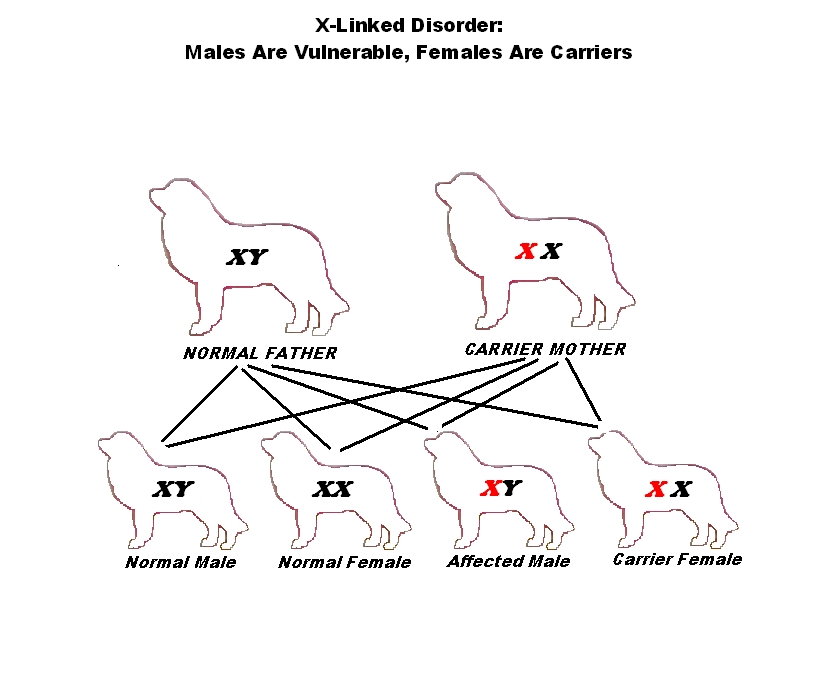X-Linked Inheritance
Generally speaking, all creatures have a set of genes carefully paired up, with half coming from their mother and the other half coming from their father, creating their own unique set of pairs. It does not matter if the offspring are themselves male or female, genetically they will have the same pattern of paired genes - but with one exception. This exception occurs in the so-called sex chromosomes, which differ from male to female. Females carry two copies of the X chromosome, and males carry one X and one Y. This simple distinction triggers all other characteristics that determine how males and females differ.
Sometimes the X chromosome itself can alter due to a random mutation and this can lead to it becoming damaged. This damage can then cause genetic illness in future generations. The way this is passed on differs from other forms of genetic diseases. If a father carries a damaged X chromosome, he passes this on to some of his offspring just as he does with all his other genes. If the resulting puppy is female and she received a normal healthy copy of the X chromosome from her mother, along with the faulty one from her father, then the good copy will over-ride the bad copy and all will be well. She will not show that illness and will live a healthy life. But, she will still carry the defect and risks passing it on in turn to her own puppies. If a carrier female passes a damaged X chromosome to a male puppy, he has no second healthy copy of the X to over-ride the information from the faulty copy, all he has is a single much shorter Y chromosome to pair it with, and this cannot “fix” the damage to the X. He will therefore become affected with the illness. So the pattern of inheritance goes from unaffected carrier females to affected males, who can then sire unaffected carrier females in turn and so on. An example of this is haemophilia which affects males and is passed on by females. X-linked inheritance can have dominant and recessive characteristics and to understand the differences have a look at this more detailed explanation: http://ghr.nlm.nih.gov/handbook
Generally speaking, all creatures have a set of genes carefully paired up, with half coming from their mother and the other half coming from their father, creating their own unique set of pairs. It does not matter if the offspring are themselves male or female, genetically they will have the same pattern of paired genes - but with one exception. This exception occurs in the so-called sex chromosomes, which differ from male to female. Females carry two copies of the X chromosome, and males carry one X and one Y. This simple distinction triggers all other characteristics that determine how males and females differ.
Sometimes the X chromosome itself can alter due to a random mutation and this can lead to it becoming damaged. This damage can then cause genetic illness in future generations. The way this is passed on differs from other forms of genetic diseases. If a father carries a damaged X chromosome, he passes this on to some of his offspring just as he does with all his other genes. If the resulting puppy is female and she received a normal healthy copy of the X chromosome from her mother, along with the faulty one from her father, then the good copy will over-ride the bad copy and all will be well. She will not show that illness and will live a healthy life. But, she will still carry the defect and risks passing it on in turn to her own puppies. If a carrier female passes a damaged X chromosome to a male puppy, he has no second healthy copy of the X to over-ride the information from the faulty copy, all he has is a single much shorter Y chromosome to pair it with, and this cannot “fix” the damage to the X. He will therefore become affected with the illness. So the pattern of inheritance goes from unaffected carrier females to affected males, who can then sire unaffected carrier females in turn and so on. An example of this is haemophilia which affects males and is passed on by females. X-linked inheritance can have dominant and recessive characteristics and to understand the differences have a look at this more detailed explanation: http://ghr.nlm.nih.gov/handbook

